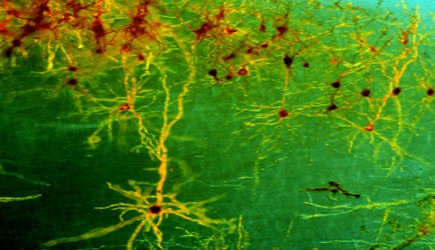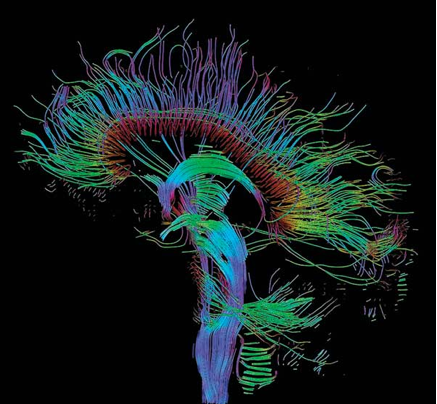Neuro-imaging Reveals: Music Changes Brains
July 20, 2012
on
on

Ongoing improvements of brain imaging technology rapidly map out the functions of the brain. Research shows music could improve quality of life.
Guest author Artur C. Jaschke researches the interrelation of music, executive functions and early brain maturation in autism spectrum disorders at the VU University Amsterdam, The Netherlands.
Let us metaphorically imagine that the brain is a house, with four walls, windows, several rooms and an entrance door. Science up to this point has entered the house and investigated every single room, turning it literally up-side down. Every room has been thoroughly examined and looked at, with astonishing findings. However, no-one seemed to have looked at the door; who is walking through or decides to stay out of that door. This door is the thalamus, which in a musical context is initially filtering out or rather channeling certain information, before it is cerebrally processed.
Throughout the research conducted in Music Cognition, scientists have continuously analyzed the effects of music on different domains of the brain. However, there is only little to no literature about this gateway to the brain, which allows to promote mental and social development, with implications reaching as far as clinical applications.
Suggestions for future improvement for quality of life within a clinical population are seemingly endless.
Reading the individual responses to music in the thalamus and further interconnected brain regions - in for example people with autism - can lead to a targeted and individualized approach in the creation of intervention programs based on music and brain function. Therefore music can support the enhancement of executive functions not only in individuals with an autism spectrum condition – who otherwise would continue suffering under this particular executive dysfunction in the prefrontal cortex – but also in neurotypical individuals.
But why music and why a central brain structure such as the thalamus?
Music is a multisensory stimulus, meaning it stimulates more than one sensory receptor in the brain. Its connection to the thalamus in interconnection with the claustrum, (a thin membrane like structure connecting different axonal pathways of one part of the cortex with another) creates a complex network of multisensory connections between the later two and the cortex (the cortex houses the four main lobes; frontal, parietal, occipital and temporal and can be seen as the surface of the brain).
[caption id="attachment_4178" align="aligncenter" width="437" caption="Tractograpy of the brainstem, thalamus and corpus callosum"] [/caption]
[/caption]
This network implies a direct effect of music on the thalamus, which in return effects the whole of the brain and therefore can reach as far as influencing our everyday life, through stimulation of for example executive functions (e.g. planning, multi-tasking, learning, working memory, decision making and problem solving, to mention a few).
The above mentioned gateway, the thalamus, is responsible for directing incoming information -as in this case: music- to the necessary brain structures in the cortex. Furthermore it regulates the hormone household in the body through the Hypothalamus. Understanding where and how the thalamus directs music and what hormonal effect is attached to it, can have immense implications for disease management and treatment.
These relationships can be made visible via neuro-imaging, such as functional Magnetic Resonance Imaging (fMRI) and Diffusion Tensor Imaging (DTI). Both techniques are not new in the field of the neurosciences, however in combination with technological advances and measurements of electrical activity on the scalp - Electroencephalography (EEG) - one can pinpoint and therefore stimulate regions in the brain.
Through the application of these 3 forms of detection in combination with a strong and unique multisensory stimulus such as music, one can identify neural pathways (axons and drivers) from the thalamus to other brain areas, whereby these cerebral areas react positively to this stimulus. This data can be translated into frequency based stimulation procedures, and accordingly trigger for example positive emotions in depressed individuals, or enhance executive functions in autism.
Once a frequency is detected, which resonates positively - in for example the amygdala, which in its simplest form is the main emotion center of the brain (through a combination of fMRI and EEG) - this frequency can be used to stimulate the related brain area again with the recorded frequency. Even though this procedure is still in the future, directed stimulation of brain areas resonating to certain recorded frequencies, can teach the brain to react to an externally applied frequency.
This triggers the release of hormones in the Hypothalmus, which in previous conjunction with the thalamus has learned a connection of music frequencies and hormone stimulation.
Therefore improving the quality of life in a wide clinical population with music, shows that it does not only stimulate the brain, but can also teach it how to change.
Guest author Artur C. Jaschke researches the interrelation of music, executive functions and early brain maturation in autism spectrum disorders at the VU University Amsterdam, The Netherlands.
Let us metaphorically imagine that the brain is a house, with four walls, windows, several rooms and an entrance door. Science up to this point has entered the house and investigated every single room, turning it literally up-side down. Every room has been thoroughly examined and looked at, with astonishing findings. However, no-one seemed to have looked at the door; who is walking through or decides to stay out of that door. This door is the thalamus, which in a musical context is initially filtering out or rather channeling certain information, before it is cerebrally processed.
Throughout the research conducted in Music Cognition, scientists have continuously analyzed the effects of music on different domains of the brain. However, there is only little to no literature about this gateway to the brain, which allows to promote mental and social development, with implications reaching as far as clinical applications.
Suggestions for future improvement for quality of life within a clinical population are seemingly endless.
Reading the individual responses to music in the thalamus and further interconnected brain regions - in for example people with autism - can lead to a targeted and individualized approach in the creation of intervention programs based on music and brain function. Therefore music can support the enhancement of executive functions not only in individuals with an autism spectrum condition – who otherwise would continue suffering under this particular executive dysfunction in the prefrontal cortex – but also in neurotypical individuals.
But why music and why a central brain structure such as the thalamus?
Music is a multisensory stimulus, meaning it stimulates more than one sensory receptor in the brain. Its connection to the thalamus in interconnection with the claustrum, (a thin membrane like structure connecting different axonal pathways of one part of the cortex with another) creates a complex network of multisensory connections between the later two and the cortex (the cortex houses the four main lobes; frontal, parietal, occipital and temporal and can be seen as the surface of the brain).
[caption id="attachment_4178" align="aligncenter" width="437" caption="Tractograpy of the brainstem, thalamus and corpus callosum"]
 [/caption]
[/caption]This network implies a direct effect of music on the thalamus, which in return effects the whole of the brain and therefore can reach as far as influencing our everyday life, through stimulation of for example executive functions (e.g. planning, multi-tasking, learning, working memory, decision making and problem solving, to mention a few).
The above mentioned gateway, the thalamus, is responsible for directing incoming information -as in this case: music- to the necessary brain structures in the cortex. Furthermore it regulates the hormone household in the body through the Hypothalamus. Understanding where and how the thalamus directs music and what hormonal effect is attached to it, can have immense implications for disease management and treatment.
These relationships can be made visible via neuro-imaging, such as functional Magnetic Resonance Imaging (fMRI) and Diffusion Tensor Imaging (DTI). Both techniques are not new in the field of the neurosciences, however in combination with technological advances and measurements of electrical activity on the scalp - Electroencephalography (EEG) - one can pinpoint and therefore stimulate regions in the brain.
Through the application of these 3 forms of detection in combination with a strong and unique multisensory stimulus such as music, one can identify neural pathways (axons and drivers) from the thalamus to other brain areas, whereby these cerebral areas react positively to this stimulus. This data can be translated into frequency based stimulation procedures, and accordingly trigger for example positive emotions in depressed individuals, or enhance executive functions in autism.
Once a frequency is detected, which resonates positively - in for example the amygdala, which in its simplest form is the main emotion center of the brain (through a combination of fMRI and EEG) - this frequency can be used to stimulate the related brain area again with the recorded frequency. Even though this procedure is still in the future, directed stimulation of brain areas resonating to certain recorded frequencies, can teach the brain to react to an externally applied frequency.
This triggers the release of hormones in the Hypothalmus, which in previous conjunction with the thalamus has learned a connection of music frequencies and hormone stimulation.
Therefore improving the quality of life in a wide clinical population with music, shows that it does not only stimulate the brain, but can also teach it how to change.
Read full article
Hide full article


Discussion (0 comments)